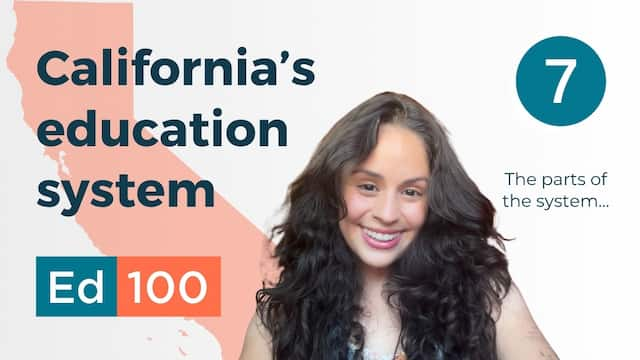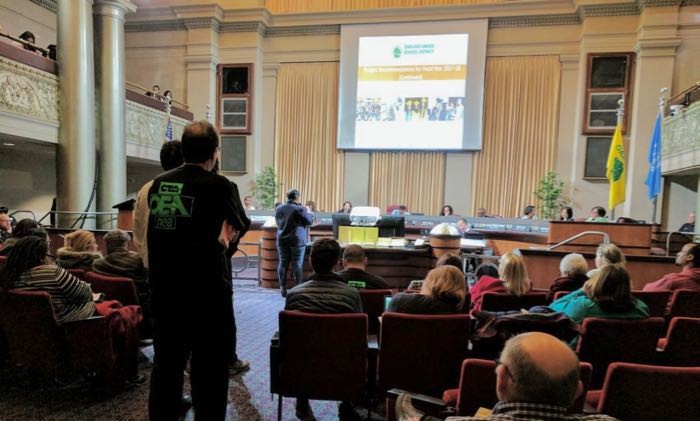
No matter where a child lives in the state of California, a public school district is obligated to provide free public education.
In This Lesson

How many school districts are in California?
What is a school district?
What do school districts do?
What is a state mandate?
Are mayors responsible for schools?
Who is in charge of school districts?
What do school site councils do?
What power do schools have in relation to the school district?
When can the state take over a school district?
How can I see my school district's budget?
▶ Watch the video summary
★ Discussion Guide
Think of the state as a jigsaw puzzle with the districts as the pieces. It's a huge puzzle, with about 1,000 pieces, not counting the state's 58 County Offices of Education.
But wait, there are some additional wrinkles. (Are you surprised?)
For one, not all California school districts serve the full range of grade levels. Actually, only about a third are unified districts, serving students from elementary through high school grades. California has about 75 districts with only high schools. The rest are elementary districts, typically serving grades K-8.
The state’s school districts vary tremendously in size. The smallest have as few as 20 students. The largest is the Los Angeles Unified School District, which is responsible for educating hundreds of thousands of the nearly 6 million children attending California's public K-12 schools.
Local Education Agencies (LEAs)
A bit of education jargon worth knowing is the term Local Education Agency, usually abbreviated as LEA. Most LEAs are school districts, but county offices of education and charter schools (which are independent of districts) are also LEAs. California's education laws frequently refer to LEAs, because "school districts and charter schools and county offices of education" is quite a mouthful.
Your school's budget is managed by your school district. Little money if any is managed at the school site level.
School districts (LEAs) are the state's fiscal agents for the use of school funds. To a limited extent, the golden rule applies: Whoever’s got the gold makes the rules. School districts have power.
Districts are responsible for passing an annual budget, hiring staff, and much more. Traditional school districts are also required by state law to have a publicly elected school board. (When boards have vacancies, boards can make appointments to fill them until the next regular election.) School boards are responsible for setting policy in a district and hiring the superintendent. The superintendent has the job of implementing policies, managing the district, and making all other hiring decisions.
Charter schools are governed differently from traditional schools. See Lesson 5.5 for more on how charter schools are created and overseen, including information about Charter Management Organizations (CMOs), which administer multiple charter schools.
Not a Mandate. Just a Suggestion
What is a state mandate?
Whenever the state legislature passes a law related to education, the law has to specify which part of the education system is responsible for carrying it out. Is it a job for the state department of education? County offices of education? School districts?
As part of the "tax revolt" movement of the late 1970s, California voters passed Proposition 4 in 1979. Among other changes, this measure created a constitutional obligation for the state to reimburse local government entities (like school districts) for the cost of implementing state mandates. Simply put, whenever the state requires a school district to do something, the state is required to cover the cost. The reimbursement process, overseen by the Commission on State Mandates, is a consistent source of tension and litigation. The California legislature tends to avoid requiring school districts to do anything that might cost money — even providing students with access to feminine hygiene products.
Avoiding mandates has had a devastating impact on the quality of data about education in California. The state cannot require districts to collect data or use a particular data system without creating a state mandate, thereby risking big claims for reimbursement. This isn't the only impediment to decent data collection in California, but it's one important reason why California's data systems are in such a bad condition. State lawmakers who care about data quietly cheer if data collection is required as a condition of a federal grant program, because then it isn't a state mandate, but a federal one. California's weak education data systems are discussed further in Lesson 9.5
Mayors? Nope. School boards? Yep.
Mayors don't run public schools.
Most people are surprised to learn that mayors and other city officials have neither responsibility nor power when it comes to the operation of public schools. School districts are independent twigs of the executive branch of government, and they are usually governed by school boards (a mostly legislative function) that are independently elected. When citizens complain to a mayor about schools, the mayor's official role is to shuffle their feet and give the audience a lesson in municipal civics.
There are occasional exceptions. In some places (mainly large cities and mainly outside of California) some mayors play a role in school governance through the appointment of members of the school board. This governance strategy is known as mayoral control. In some districts (e.g. San Francisco, notably, in 2022), the mayor plays a role in appointing replacements for board members who are recalled from office.
Local school boards can serve as agents for change. In some cities (for example, Houston and Los Angeles), citizen groups have invested enormous energy to field and support candidates with a shared agenda, such as whether to encourage or discourage the formation of charter schools. In California, where Proposition 13 removed school boards’ authority to set tax rates, most school board elections have been relatively sleepy affairs with low voter turnout despite the many important reasons to pay attention - and vote - in them.
In 2018, an important and precedent-setting lawsuit under the California Voting Rights Act changed the way that school board elections work in California. In the past, most school board members (also known as trustees)represented all students and all schools at large in a district. The suit ruled that at-large representation can be insufficient; districts must be subdivided into smaller voting districts often called trustee areas. Voters residing in each of these smaller areas now separately elect their board representatives, who must be residents of the trustee area. The transition away from at-large representation swiftly unseated incumbent board members throughout the state.
An advantage of this model of representation is that each school and each school community clearly has a board member who ought to have their ear and their back. On the other hand, this arrangement can make some decisions (such as whether to close a poorly performing school) more painful and political than ever.
California’s 2013 adoption of the Local Control Funding Formula (LCFF) substantially increased the power of school boards to set local priorities through their budgets. (See Lesson 7.8 for more about this.) School boards are public entities that must operate under public scrutiny subject to an open meeting law known as the Brown Act. In 2020, the COVID-19 pandemic made meetings in person unsafe, so the meaning of open meeting was expanded by executive action to include virtual meetings.
Site-based Control
Individual school sites have some limited decision-making authority under certain state and federal programs.
Some districts concentrate decision authority in the central office; others devolve power to school leaders.
The federal Every Student Succeeds Act requires that each school create a School Plan for Student Achievement to document how certain federal funds are spent. In California, this federal requirement is matched by state requirements. Every school should have an active site council, a topic that we explore in some detail in the Ed100 blog post How Do Schoolsite Councils Work? Schools with more than 21 English learners, and districts with more than 51, are required to have an advisory committees (known as an ELAC for a school or DELAC for a district) specifically to focus on English learners.
The relationship between school districts and their schools can vary enormously. Many districts concentrate decision authority in the central office office, but all devolve some power to school leaders. Some school reformers see this kind of decentralization as a critical strategy for educational improvement. Major areas where districts sometimes give sites discretion include:
- Site-level budgeting authority. This can be limited to funds for dry-erase markers, or can include every part of school operations and personnel.
- Hiring decisions. In California, decisions to hire teachers (or let them go) are made at the district level, but faculty may be involved in the process.
- Placement decisions. In many districts, teachers may be assigned to schools without the principal having much say.
- Instructional decisions. Districts may give teachers discretion over matters such as textbook selection, grouping practices, and student support programs for low-achieving students.
- Special programs. Outside the regular school day, schools might vary programs including parent education, after-school programs, and community partnerships.
In a state as big as California, there are always exceptions. A few California districts are always experimenting with ways to give school sites more autonomy.
State Takeovers
Schools are locally administered, but not unconditionally. Ultimately, the California constitution obligates the state to provide for education. If a district fails abjectly, particularly through financial mismanagement, it can be placed under state administration until it gets its house in order. Colloquially, this is called a state takeover.
In these rare circumstances, a State-appointed Administrator combines the functions of the school board and the superintendent into a single office. These state takeovers are rare in part for a practical reason: turning around a district in crisis is incredibly difficult, politically-charged work. Wherever possible, it is best for districts and boards to get their own house in order. To head off these problems before they happen, the state relies on County Offices of Education. These offices oversee the finances of school districts and certify their fiscal condition twice a year, using a consistent set of standards. The oversight process is supported by FCMAT (Fiscal Crisis and Management Assistance Team).
The work of FCMAT is meant to help prevent fiscal disasters in districts. But what about educational disasters? In 2016, The California Legislature created the California Collaborative for Educational Excellence (CCEE) to provide "advice and assistance" to county offices of education, school districts, and charter schools in achieving their LCAP goals. Districts sometimes resent being told they need outside help, but they usually miss it when they improve to a level that they no longer qualify. (More on this topic in Lesson 7.9.)
Charter School Governance
As discussed in Lesson 5.5, California’s 1,300+ charter schools operate somewhat outside of this system of local governance. Charter schools are authorized by a school district or county office of education, subject to written expectations(the charter agreement). They are accountable for performance and can be closed by their chartering authority if they don’t meet certain goals or don’t operate in a financially responsible manner.
District Organizations
Clearly, school districts serve a vital educational role. They are also economically important as employers and service providers. In addition to teachers, districts hire a lot of staff, including administrators, counselors, aides, and specialists. Districts maintain and upgrade school facilities. They coordinate with city public services on everything from crossing guards and bus routes to police coverage. In 2023-24, California’s public school system in aggregate employed 285,891 certificated educators (mostly teachers) and 318,576 classified staff members [2025].
The organizational structure and personnel investments of districts can differ a lot. School district budgets are public information, but hard to understand in isolation. In California, the district financial reports on the Ed-Data Partnership website show how school districts allocate resources and allow comparisons. But high-level comparisons of staffing structures should be taken with some skepticism. Schools involve a lot of part-time roles, from crossing guard to band teacher to website manager to department chair. Those nuances make comparisons wiggly. Also, because schools are of different sizes, specialist roles like counseling are often shared across campuses.
When comparing the organizational investments of different schools, it helps to think in terms of the number of full-time equivalent (FTE) positions associated with a role at a school. It also helps to compare that number to the number of students affected. Staffing ratios can often paint a picture more informative than a simple organization chart can provide.
Updated in July 2025.
CHAPTER 7:
And a System…
-
And a System…
Overview of Chapter 7 -
The Role of State Government in Education
California’s Constitutional Responsibility -
The Federal Government and Education
Small money, Big Influence -
School Districts in California
What do School Districts Do? -
County Offices of Education
Oversight and Regional Services -
Teachers' Unions in California
What do Teacher Unions Do? -
Ballot Initiatives and Education
California's Initiative Process and How It Affects Schools -
Who Influences Education?
Politics, Philanthropy and Policy -
Accountability in Education
Who Monitors the Quality of Schools? -
What to Do with Failing Schools
Interventions and Consequences in California -
The LCAP
Annual Plans for California School Districts
Related
Sharing is caring!
Password Reset
Search all lesson and blog content here.
Login with Email
We will send your Login Link to your email
address. Click on the link and you will be
logged into Ed100. No more passwords to
remember!


















Questions & Comments
To comment or reply, please sign in .
Jeff Camp - Founder June 26, 2025 at 2:42 pm
Jeff Camp - Founder January 18, 2022 at 11:50 am
francisco molina August 19, 2019 at 1:10 am
Denise Dafflon July 2, 2019 at 2:10 am
When common core are introduced or the California Framework for ELA and ELD or how students with special needs are served... is it a state required mandate to an LEA or is it just a suggestion?
When LEA have diffiulties to implement these madates/suggestions (?) (manly because of the lack of financial ressources)... then where should advocacy be directed to to make changes? toward LEA or State (directly? to state legislators? governor? or through Commission on State Mandates?... waow, so much to learn!
Is there a particular lesson on Ed 100 to help me (us?) figure that out?
Jeff Camp July 6, 2019 at 6:00 pm
Denise Dafflon July 7, 2019 at 12:20 pm
Caryn July 30, 2019 at 10:21 am
francisco molina February 17, 2019 at 1:52 pm
Brandi Galasso September 30, 2015 at 7:53 pm